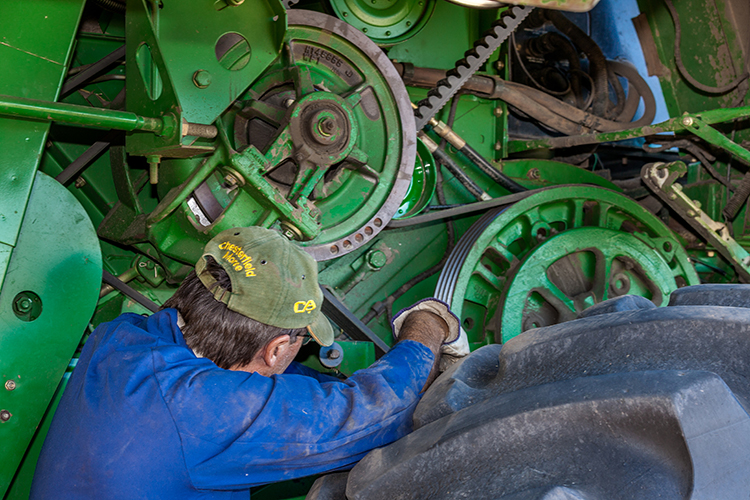
As we are coming out of the challenges of the COVID-19 pandemic, businesses across the country are revisiting strategies to address worker health and safety with a new appreciation of the merits of having a healthy workforce. Businesses are entertaining new approaches to fostering worker wellness and health as an unhealthy workforce is now recognized as a risk to the sustainability of a business.
Health and safety should be a priority for every business, large and small. For many industries including dairy, workplace safety is not optional; it is a legal obligation. A safety system should not just keep workers safe. An effective safety management system will also assist with the efficiency and productivity of workers on a farm.
A well-designed safety system should avoid safety incidents by identifying risks from hazards before they become a problem. Dairy owners and managers should feel confident that an effective safety system will help reduce the multiple risks associated with worker injuries or fatalities. A hazard is defined as anything that can cause harm. Risk is the chance or likelihood of a hazard causing harm to not only the worker but also the business.
Dairy farmers face a variety of challenges when it comes to health and safety. Workers are frequently dealing with large and often unpredictable cows, as well as operating a range of machinery. Daily hazards also include accessing confined spaces like manure lagoons or storage facilities, electrical and chemicals hazards, and unique hazards such as silage storage facilities.
As dairy farms continue to address these workplace safety hazards, many employers in the industry are considering additional strategies to facilitate a healthy workforce and including these strategies in their overall risk mitigation program.
While musculoskeletal injuries represent a significant burden for dairy workers, the weight of other chronic illnesses or conditions is now being recognized as a significant health risk for dairy workers. The prevalence of diagnosed and undiagnosed diabetes and hypertension is highest among Hispanics. Cardiovascular risk factors, including obesity, diabetes, and high cholesterol, are more prevalent among immigrant agricultural workers and Hispanics than the general U.S. population. Moreover, control of these chronic conditions is generally poor in the Hispanic population, causing a higher burden of disease complications and, subsequently, quality of life.
Most recently, the novel coronavirus has disproportionally affected U.S. Hispanics. Diagnosed and undiagnosed as well as controlled and uncontrolled chronic diseases, such as - diabetes, hypertension, high cholesterol, obesity, kidney, and cardiovascular disease - have been recognized to increase COVID-19 disease severity and progression to hospitalization and death. From March 2020 to October 2021, the age-adjusted COVID-19- associated hospitalization rates for Hispanics were 1,181.9 per 100,000 population, a rate 2.6 times that of non-Hispanic whites.
Beyond the immediate impact on the health of agricultural workers, research has revealed reductions in agricultural labor due to the COVID-19 pandemic adversely affected the U.S. food supply. Over the 13-month period from March 1, 2020, to March 31, 2021, COVID-19 resulted in an estimated 0.07% reduction in farm labor input, resulting in a loss of $309 million.
Hispanic agricultural workers often have limited access to healthcare services. Some of the many barriers to healthcare access include:
• Cost
• Transportation
• Language and translation challenges
• Absence of health insurance
• Cultural differences
• Limited knowledge of health centers and locations
• Work schedule and time conflicts
• Lack of childcare
• Unavailability of specialty services
• Transient or migratory lifestyle
• Fear of law and immigration enforcement
These barriers often lead to an increase in self-reliant attitudes and greater dependence on home remedies and self-prescription therapies. These alternative medicine practices, in addition to delayed healthcare, can lead to chronic illnesses and elevated disease severity. Hispanic migrant and seasonal farmworkers often exhibit poor self-management of chronic diseases like diabetes, hypertension, and tuberculosis due to economic challenges and lack of follow-up care with health care providers.
The COVID-19 pandemic has presented multiple challenges for the dairy industry and has revealed the value of having a healthy workforce. An unhealthy dairy workforce can raise risk for a dairy business and negatively influence dairy farm sustainability.
Dairy employers are beginning to consider other strategies to promote the health and welfare of dairy workers, such as new partnerships with immigrant health centers to provide health and wellness services to farm employees. These services can be delivered to workers on the farm, without any expense to the employer. The Idaho Dairymen’s Association continues to seek new partnerships with immigrant clinician networks and health promotion services to help dairy employers facilitate a healthy workforce on the farm.
Editor’s note: This article originally appeared in the first quarter 2022 edition of the Idaho Dairy Focus.





